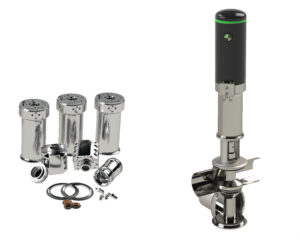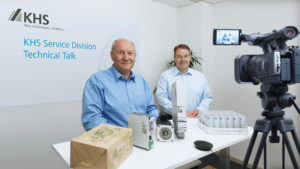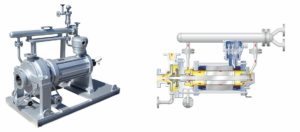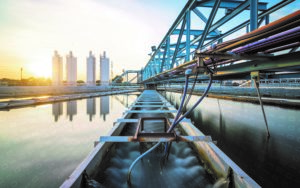高压技术对CO2-Ext密封raction in Lavazza’s Decaffeination Process

High-pressure technology from HERMETIC for CO2-extraction in Lavazza's decaffeination process. (Image source: HERMETIC-Pumpen GmbH)
在高温和extr结合emely low viscosity of the fluid, the process places high demands on the equipment installed. A canned motor pump designed and produced by HERMETIC-Pumpen GmbH is employed as circulation pump. The compact unit in high-pressure design, including monitoring equipment, ensures a reliable flow of CO2through the coffee beans. Thanks topumps’s low-wear and low-maintenance design, caffeine can be extracted in a 24-hour operation without compromising the service life.
Supercritical carbon dioxide is in a supercritical state above its critical temperature and pressure. Its properties lie between those of a gas and a liquid: it has the viscosity, compressibility and diffusivity of a gas and the density and solubility of a liquid. It can easily penetrate other substances and extract the desired substances from them. Due to its natural qualities and the purity of the end product, it is mainly used in the food and pharmaceutical industries. One example is the decaffeination of coffee beans.
Lavazza: "natural" decaffeination CO2process.
Decaffeination is a process to extract the caffeine from the coffee beans while they are still green. Lavazza only uses the CO2method. Decaffeination takes place through a "natural" process where all elements that come into contact with the product during the various processing steps are suitable for food use.
In the Lavazza plant located in Pozzilli in the Italian region of Molise – put into operation for this purpose in 1991 – the green coffee beans are first swollen by increasing their moisture content to over 35 % with the addition of drinking water. The beans are then directed into an extractor (autoclave) where carbon dioxide flows under supercritical conditions. With this process, the caffeine is extracted from the coffee beans and then recovered. At the end of the extraction phase, the autoclave containing the coffee is depressurised and the coffee is transferred to the next drying phase. In this processing step, the coffee beans are dried until they reach a moisture content of less than 11 %.
High pressure, high temperature, low viscosity
Using CO2in a supercritical state of aggregation is the key for a successful caffeine extraction. The prevailing high temperature results in extremely high vapor pressure at the lowest viscosities. This represents an extraordinary challenge for the centrifugal pump. The mixture of CO2, water and caffeine may also lead to residues, flowing through the pump.
Hermetically sealed pump solution in high-pressure design
For conveying the supercritical CO2through the extractor, Lavazza relies on a centrifugal canned motor pump from HERMETIC-Pumpen GmbH. The high-pressure multi-stage centrifugal pump, type CAMHV ensures the reliable delivery. The process conditions foresee a pressure of over 200 bar, a temperature of over 80 °C and a CO2flow of more than 140 m³/h. In canned motor pumps, the motor and the hydraulic components are part of one block with rotor and impellers being arranged on a common shaft. The rotor is supported by medium-lubricated radial bearings. The stator of the drive motor is separated from the rotor chamber by a stator tube. The rotor chamber forms a common space with the housing part of the pump.
A low-wear design principle for 24-hour continuous operation
Thanks to its integral and compact design, the canned motor pump does not require shaft seals, conventional bearings or couplings. This is an advantage over pumps with mechanical seals that are more susceptible to the pressures and temperatures prevailing in the extraction process. The pump also runs very low noise emission.
The HERMETIC technology "ZART" (Zero Axial and Radial Thrust) ensures that the rotor unit runs without contact and wear. ZART is based on comprehensive axial thrust balancing using non-contact hydrodynamic plain bearings. The pump was installed in vertical position to accommodate the low viscosity of the pumped medium and the resulting reduced bearing load capacity. In this case, the plain bearings do not have a rotor load support function, but only a guiding function. The rotor weight is carried hydrostatically. This design allows the rotor to work in continuous operation without wear and mechanical contacts. This enables caffeine extraction in continuous operation for several years. Another advantage of the vertical installation is to facilitate the pump degassing operations.
Reliable axial thrust balancing with rotor position monitoring
In canned motor pumps, the axial position of the pump shaft balances itself automatically during operation. This establishes a force-free state of equilibrium automatically and no axial forces act on the axial bearing collar of the plain bearings. In the pump installed in the Lavazza plant, an axial control disc ensures axial thrust balancing. The pump is equipped with the HERMETIC rotor position monitor “MAP” to monitor the axial rotor balancing during operation of the pump. The rotor position monitoring detects the slightest deviation of the rotor outside the permissible range and serves as an early warning system to prevent undesirable operating conditions.
Knowledge and experience in the most unusual applications
With this demanding application, HERMETIC demonstrates decades of experience in hermetically sealed pumps even in complex and critical processes. In close cooperation with customers, HERMETIC is constantly introducing new applications to the market. This makes HERMETIC one of the leading manufacturers of hermetically sealed pumps worldwide.
Source:Hermetic-Pumpen GmbH







